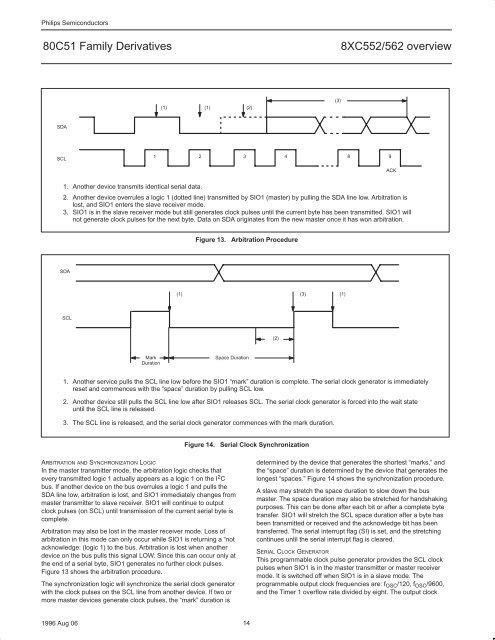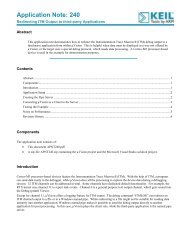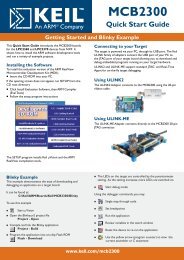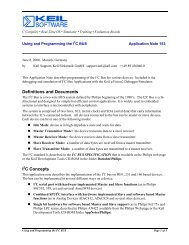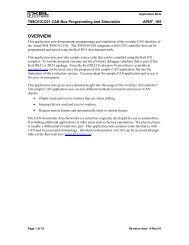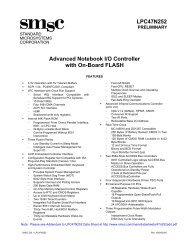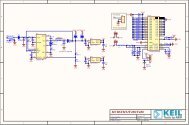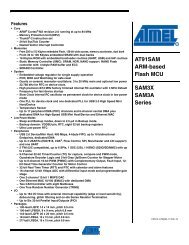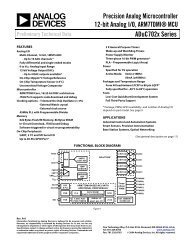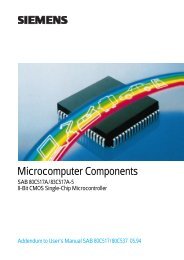NXP 80C552, 83/87C552, P80C562, P83C562 Family Overview - Keil
NXP 80C552, 83/87C552, P80C562, P83C562 Family Overview - Keil
NXP 80C552, 83/87C552, P80C562, P83C562 Family Overview - Keil
Create successful ePaper yourself
Turn your PDF publications into a flip-book with our unique Google optimized e-Paper software.
Philips Semiconductors<br />
80C51 <strong>Family</strong> Derivatives 8XC552/562 overview<br />
SDA<br />
SCL<br />
1. Another device transmits identical serial data.<br />
(1) (1) (2)<br />
1996 Aug 06 14<br />
1 2 3 4 8 9<br />
2. Another device overrules a logic 1 (dotted line) transmitted by SIO1 (master) by pulling the SDA line low. Arbitration is<br />
lost, and SIO1 enters the slave receiver mode.<br />
3. SIO1 is in the slave receiver mode but still generates clock pulses until the current byte has been transmitted. SIO1 will<br />
not generate clock pulses for the next byte. Data on SDA originates from the new master once it has won arbitration.<br />
SDA<br />
SCL<br />
Mark<br />
Duration<br />
(1)<br />
Figure 13. Arbitration Procedure<br />
Space Duration<br />
(2)<br />
(3)<br />
(3) (1)<br />
1. Another service pulls the SCL line low before the SIO1 “mark” duration is complete. The serial clock generator is immediately<br />
reset and commences with the “space” duration by pulling SCL low.<br />
2. Another device still pulls the SCL line low after SIO1 releases SCL. The serial clock generator is forced into the wait state<br />
until the SCL line is released.<br />
3. The SCL line is released, and the serial clock generator commences with the mark duration.<br />
ARBITRATION AND SYNCHRONIZATION LOGIC<br />
In the master transmitter mode, the arbitration logic checks that<br />
every transmitted logic 1 actually appears as a logic 1 on the I2C bus. If another device on the bus overrules a logic 1 and pulls the<br />
SDA line low, arbitration is lost, and SIO1 immediately changes from<br />
master transmitter to slave receiver. SIO1 will continue to output<br />
clock pulses (on SCL) until transmission of the current serial byte is<br />
complete.<br />
Arbitration may also be lost in the master receiver mode. Loss of<br />
arbitration in this mode can only occur while SIO1 is returning a “not<br />
acknowledge: (logic 1) to the bus. Arbitration is lost when another<br />
device on the bus pulls this signal LOW. Since this can occur only at<br />
the end of a serial byte, SIO1 generates no further clock pulses.<br />
Figure 13 shows the arbitration procedure.<br />
The synchronization logic will synchronize the serial clock generator<br />
with the clock pulses on the SCL line from another device. If two or<br />
more master devices generate clock pulses, the “mark” duration is<br />
Figure 14. Serial Clock Synchronization<br />
ACK<br />
determined by the device that generates the shortest “marks,” and<br />
the “space” duration is determined by the device that generates the<br />
longest “spaces.” Figure 14 shows the synchronization procedure.<br />
A slave may stretch the space duration to slow down the bus<br />
master. The space duration may also be stretched for handshaking<br />
purposes. This can be done after each bit or after a complete byte<br />
transfer. SIO1 will stretch the SCL space duration after a byte has<br />
been transmitted or received and the acknowledge bit has been<br />
transferred. The serial interrupt flag (SI) is set, and the stretching<br />
continues until the serial interrupt flag is cleared.<br />
SERIAL CLOCK GENERATOR<br />
This programmable clock pulse generator provides the SCL clock<br />
pulses when SIO1 is in the master transmitter or master receiver<br />
mode. It is switched off when SIO1 is in a slave mode. The<br />
programmable output clock frequencies are: f OSC/120, f OSC/9600,<br />
and the Timer 1 overflow rate divided by eight. The output clock


